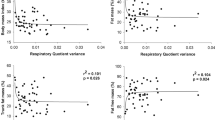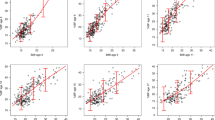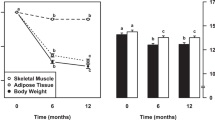Abstract
Background/Objectives:
Metabolic disturbances, such as reduced rates of fat oxidation (high respiratory quotient (RQ)) or low energy expenditure (low resting metabolic rate (RMR)), may contribute to obesity. The objective was to determine the association between a high RQ or a low RMR and changes in body weight and body composition over 1 year.
Subjects/Methods:
We measured RQ and RMR in 341 adults using indirect calorimetry, along with body weight/body composition using dual-energy X-ray absorptiometery, energy expenditure using an arm-based activity monitor and energy intake using dietary recalls. Participants were classified into low, moderate or high RQ and RMR (adjusted for age, sex, race and body composition) groups according to tertiles by sex. Follow-up measurements were completed every 3 months.
Results:
Individuals with a high RQ had larger gains in body weight and fat mass compared with individuals with a low/moderate RQ at month 3, and increases in fat mass were more than double among individuals with a high RQ at 12 months (1.3±3.0 vs 0.6±3.7 kg, P=0.03). Individuals with a low RMR did not gain more body weight nor fat mass compared with individuals with a moderate/high RMR.
Conclusion:
The primary finding is a high RQ is predictive of gains in body weight and fat mass over a 12-month period among young adults, with changes occurring as soon as 3 months. In addition, a low RMR was not associated with gains in body weight or fat mass over the same period.
This is a preview of subscription content, access via your institution
Access options
Subscribe to this journal
Receive 12 print issues and online access
$259.00 per year
only $21.58 per issue
Buy this article
- Purchase on Springer Link
- Instant access to full article PDF
Prices may be subject to local taxes which are calculated during checkout

Similar content being viewed by others
References
Marra M, Scalfi L, Covino A, Esposito-Del Puente A, Contaldo F . Fasting respiratory quotient as a predictor of weight changes in non-obese women. Int J Obes Relat Metab Disord 1998; 22: 601–603.
Seidell JC, Muller DC, Sorkin JD, Andres R . Fasting respiratory exchange ratio and resting metabolic rate as predictors of weight gain: the Baltimore Longitudinal Study on Aging. Int J Obes Relat Metab Disord 1992; 16: 667–674.
Zurlo F, Lillioja S, Esposito-Del Puente A, Nyomba BL, Raz I, Saad MF et al. Low ratio of fat to carbohydrate oxidation as predictor of weight gain: study of 24-h RQ. Am J Physiol 1990; 259 (5 Pt 1), E650–E657.
Ellis AC, Hyatt TC, Hunter GR, Gower BA . Respiratory quotient predicts fat mass gain in premenopausal women. Obesity (Silver Spring) 2010; 18: 2255–2259.
Katzmarzyk PT, Perusse L, Tremblay A, Bouchard C . No association between resting metabolic rate or respiratory exchange ratio and subsequent changes in body mass and fatness: 5-1/2 year follow-up of the Quebec family study. Eur J Clin Nutr 2000; 54: 610–614.
Ravussin E, Bogardus C . Relationship of genetics, age, and physical fitness to daily energy expenditure and fuel utilization. Am J Clin Nutr 1989; 49 (5 Suppl), 968–975.
Astrup A, Gotzsche PC, van de Werken K, Ranneries C, Toubro S, Raben A et al. Meta-analysis of resting metabolic rate in formerly obese subjects. Am J Clin Nutr 1999; 69: 1117–1122.
Ravussin E, Lillioja S, Knowler WC, Christin L, Freymond D, Abbott WG et al. Reduced rate of energy expenditure as a risk factor for body-weight gain. N Engl J Med 1988; 318: 467–472.
Leibel RL, Rosenbaum M, Hirsch J . Changes in energy expenditure resulting from altered body weight. N Engl J Med 1995; 332: 621–628.
Ravussin E, Lillioja S, Anderson TE, Christin L, Bogardus C . Determinants of 24-hour energy expenditure in man: methods and results using a respiratory chamber. J Clin Invest 1986; 78: 1568–1578.
Hand GA, Shook RP, Paluch AE, Baruth M, Crowley EP, Jaggers J et al. The Energy Balance Study: the design and baseline results for a longitudinal study of energy balance. Res Q Exerc Sport 2013; 84: 1–12.
Branson RD, Johannigman JA . The measurement of energy expenditure. Nutr Clin Pract 2004; 19: 622–636.
Henry CJ . Basal metabolic rate studies in humans: Measurement and development of new equations. Public Health Nutr 2005; 8: 1133–1152.
Weir JB . New methods for calculating metabolic rate with special reference to protein metabolism. J Physiol 1949; 109: 1–9.
Weir JB . New methods for calculating metabolic rate with special reference to protein metabolism. 1949. Nutrition 1990; 6: 213–221.
Roza AM, Shizgal HM . The Harris Benedict equation reevaluated: resting energy requirements and the body cell mass. Am J Clin Nutr 1984; 40: 168–182.
Mifflin MD, St Jeor ST, Hill LA, Scott BJ, Daugherty SA, Koh YO . A new predictive equation for resting energy expenditure in healthy individuals. Am J Clin Nutr 1990; 51: 241–247.
Troiano RP, Berrigan D, Dodd KW, Masse LC, Tilert T, McDowell M . Physical activity in the United States measured by accelerometer. Med Sci Sports Exerc 2008; 40: 181–188.
St-Onge M, Mignault D, Allison DB, Rabasa-Lhoret R . Evaluation of a portable device to measure daily energy expenditure in free-living adults. Am J Clin Nutr 2007; 85: 742–749.
Welk GJ, McClain JJ, Eisenmann JC, Wickel EE . Field validation of the MTI Actigraph and BodyMedia armband monitor using the IDEEA monitor. Obesity (Silver Spring) 2007; 15: 918–928.
Johannsen DL, Calabro MA, Stewart J, Franke W, Rood JC, Welk GJ . Accuracy of armband monitors for measuring daily energy expenditure in healthy adults. Med Sci Sports Exerc 2010; 42: 2134–2140.
Thompson FE, Subar AF . Chapter 1—Dietary assessment methodology. In: Nutrition in the Prevention and Treatment of Disease, 3rd edn. Academic Press: Oxford, UK, 2013, pp 5–46.
Dwyer J, Ellwood K, Leader NP, Moshfegh AJ, Johnson CL . Integration of the Continuing Survey of Food Intakes by Individuals and the National Health And Nutrition Examination Survey. J Am Diet Assoc 2001; 101: 1142–1143.
Hebert JR, Ebbeling CB, Matthews CE, Hurley TG, Ma Y, Druker S et al. Systematic errors in middle-aged women's estimates of energy intake: comparing three self-report measures to total energy expenditure from doubly labeled water. Ann Epidemiol 2002; 12: 577–586.
West BT, Welch KB, Galecki AT . In: Linear Mixed Models: a Practical Guide Using Statistical Software. Chapman & Hall/CRC: Boca Raton, 2007.
Sheehan TJ, DuBrava S, DeChello LM, Fang Z . Rates of weight change for black and white Americans over a twenty year period. Int J Obes Relat Metab Disord 2003; 27: 498–504.
Toubro S, Christensen NJ, Astrup A . Reproducibility of 24-h energy expenditure, substrate utilization and spontaneous physical activity in obesity measured in a respiration chamber. Int J Obes Relat Metab Disord 1995; 19: 544–549.
Loos RJ, Ruchat S, Rankinen T, Tremblay A, Perusse L, Bouchard C . Adiponectin and adiponectin receptor gene variants in relation to resting metabolic rate, respiratory quotient, and adiposity-related phenotypes in the Quebec Family Study. Am J Clin Nutr 2007; 85: 26–34.
Kelley DE . Skeletal muscle fat oxidation: timing and flexibility are everything. J Clin Invest 2005; 115: 1699–1702.
Ukropcova B, McNeil M, Sereda O, de Jonge L, Xie H, Bray GA et al. Dynamic changes in fat oxidation in human primary myocytes mirror metabolic characteristics of the donor. J Clin Invest 2005; 115: 1934–1941.
Colberg SR, Simoneau JA, Thaete FL, Kelley DE . Skeletal muscle utilization of free fatty acids in women with visceral obesity. J Clin Invest 1995; 95: 1846–1853.
Kunz I, Schorr U, Rommling K, Klaus S, Sharma AM . Habitual fat intake and basal fat oxidation in obese and non-obese Caucasians. Int J Obes Relat Metab Disord 2002; 26: 150–156.
Astrup A, Buemann B, Western P, Toubro S, Raben A, Christensen NJ . Obesity as an adaptation to a high-fat diet: evidence from a cross-sectional study. Am J Clin Nutr 1994; 59: 350–355.
Henriksson J . Muscle fuel selection: effect of exercise and training. Proc Nutr Soc 1995; 54: 125–138.
Schutz Y . Abnormalities of fuel utilization as predisposing to the development of obesity in humans. Obes Res 1995; 3 (Suppl 2), 173S–178S.
Calles-Escandon J, Goran MI, O'Connell M, Nair KS, Danforth E Jr . Exercise increases fat oxidation at rest unrelated to changes in energy balance or lipolysis. Am J Physiol 1996; 270 (6 Pt 1), E1009–E1014.
Lowell BB, Spiegelman BM . Towards a molecular understanding of adaptive thermogenesis. Nature 2000; 404: 652–660.
Snitker S, Tataranni PA, Ravussin E . Respiratory quotient is inversely associated with muscle sympathetic nerve activity. J Clin Endocrinol Metab 1998; 83: 3977–3979.
Ravussin E . Low resting metabolic rate as a risk factor for weight gain: role of the sympathetic nervous system. Int J Obes Relat Metab Disord 1995; 19 (Suppl 7), S8–S9.
Acknowledgements
We thank the participants of the present study for volunteering their time and effort. In addition, we are grateful to the project staff for their tireless efforts with data collection and study management, specifically Patrick Crowley, Madison Demello, Beth Lach, Reena Patel and Sarah Schumacher.
Author information
Authors and Affiliations
Corresponding author
Ethics declarations
Competing interests
This study was supported by an unrestricted research grant from the Coca-Cola Company. SNB received book royalties (<$5000 per year) from Human Kinetics, honoraria for service on the Scientific/Medical Advisory Boards for Technogym, Santech, Cancer Fit Steps for Life and Clarity, and honoraria for lectures and consultations from scientific, educational and lay groups. During the past 5-year period he has received research grants from the National Institutes of Health, Department of Defense, Body Media and the Coca-Cola Company. In the last 3 years, GAH has received funding from the National Institutes of Health, Health Resources and Services Administration, American Heart Association, the Coca Cola Company and TechnoGym. JRH was supported by an Established Investigator Award in Cancer Prevention and Control from the Cancer Training Branch of the National Cancer Institute (K05 CA136975). The remaining authors declare no conflict of interest.
Additional information
Supplementary Information accompanies this paper on European Journal of Clinical Nutrition website
Supplementary information
Rights and permissions
About this article
Cite this article
Shook, R., Hand, G., Paluch, A. et al. High respiratory quotient is associated with increases in body weight and fat mass in young adults. Eur J Clin Nutr 70, 1197–1202 (2016). https://doi.org/10.1038/ejcn.2015.198
Received:
Revised:
Accepted:
Published:
Issue Date:
DOI: https://doi.org/10.1038/ejcn.2015.198
This article is cited by
-
Neurocomputational mechanisms of food and physical activity decision-making in male adolescents
Scientific Reports (2023)
-
The association of low serum salivary and pancreatic amylases with the increased use of lipids as an energy source in non-obese healthy women
BMC Research Notes (2020)
-
Preoperative high respiratory quotient correlates with lower weight loss after bariatric surgery
Surgical Endoscopy (2020)
-
Changes in fat oxidation in response to various regimes of high intensity interval training (HIIT)
European Journal of Applied Physiology (2018)
-
Indirect calorimetry: an indispensable tool to understand and predict obesity
European Journal of Clinical Nutrition (2017)



